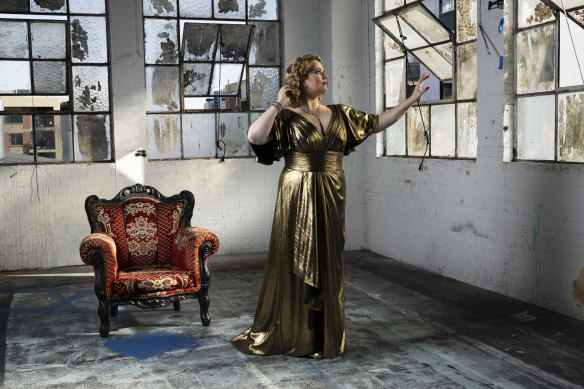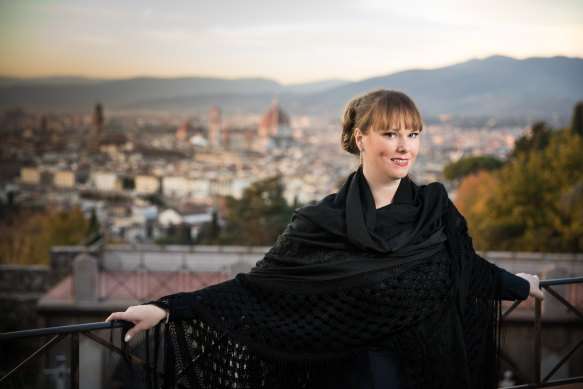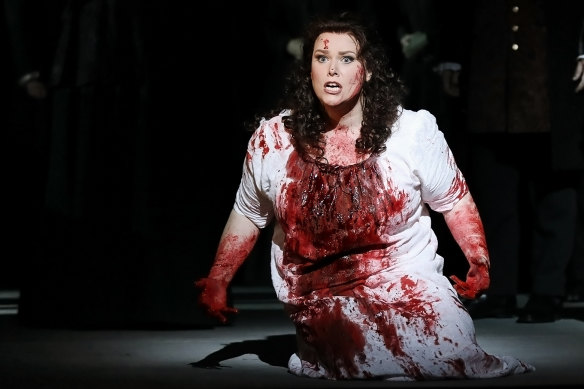By Neha Kale
Jessica Pratt has never been diverted by obstacles. She’s always known that a low point is just a plot twist - as it is for the women she portrays.
Pratt describes a phase, in her mid 20s, when she had relocated from Sydney to Europe. She didn’t work for four years and she lived out of caravans. Now, she is one of the world’s most renowned coloratura sopranos (someone known for singing high, light, and fast notes). Her patience paid off.

Jessica Pratt is a world-renowned Australian soprano.Credit: Louise Kennerley
“I had an audition and had bought this skirt from a thrift store and it had a hole in the back. All the other girls were so dressed up,” she says. “I was too proud to ask my parents for help. But I called and said, ‘please send me some money’.” She smiles ruefully. “Thanks, dad.”
Pratt now lives in Florence, Italy, but she’s currently in Sydney to rehearse for Opera Australia’s upcoming production of The Tales of Hoffmann. The opera fantastique, a form that blends drama and fantasy, was conceived in the late 1870s by the French-German composer Jacques Offenbach. It tells the story of a drunk poet, E. T. A. Hoffmann. He recounts, for the audience, his four great loves: a courtesan, an opera singer, a wind-up doll and the woman who blends all of them. In the Opera Australia production, Pratt plays all four of Hoffmann’s loves.
“Many theatres today hire a coloratura soprano for Olympia, a lyric soprano for Antonia and a mezzo soprano for Stella and Giulietta, but it was originally written for one soprano, not four different voice types,” she says. “You really do get to perform four characters in one show. It is extremely difficult to do well.”

Pratt in her adopted home of Florence.Credit: Alessandro Moggi
In conversation, Pratt is somehow both self-deprecating and regal. In speech, her voice, once described by The New York Times as an exemplar of “lyrical grace”, seems to hover above place and time.
The hint of an Australian drawl dovetails with the rolling Italian ‘r’, an aural version of her biography. The daughter of a tenor, she moved from Bristol to Sydney at 11. She was later brought to Italy by the Italian conductor Gianluigi Gelmetti, who was then the artistic director of the Sydney Symphony Orchestra and had seen her perform in a competition. She went on to study under Italian soprano Renata Scotto at the Accademia Nazionale di Santa Cecilia in Rome.
“That competition was very good for me,” says Pratt. In Italy, observing Gelmetti in rehearsal and taking masterclasses with Scotto instilled her command of bel canto, Italian for “beautiful singing”, paving the way for her 2007 European debut.
To the outsider, opera, a realm of high emotion, is populated by fallen women. Aida hides herself in a vault. Tosca leaps to her death.

Pratt in Opera Australia’s Lucia di Lammermoor at Sydney Opera House.Credit: Prudence Upton
Pratt sees it a little differently. She made her name on the global stage in Lucia di Lammermoor, a tragic opera by Italian composer Gaetano Donizetti that follows the lovers Lucia and Edgardo, members of rival houses in Scotland. Lucia, who Pratt has played more than 45 times, everywhere from Milan’s Teatro alla Scala to the Metropolitan Opera in New York, is famous for her “mad scene”.
“Lucia really loses her sense of self,” she explains. “She comes out covered in blood.”
The culture has long used accusations of hysteria to discredit women. Pratt is fiercely protective of Lucia. She believes that for the women she plays, madness is a fitting response to a society that denies their agency.
“The only way they could be free was in madness, when they have control of their lives, choose who they could marry,” she says. “In opera, the woman, when she loses the man, goes insane, and when the lover [returns], she comes back to herself. That still happens today.”
In August, after The Tales of Hoffmann closes, Pratt will perform the ‘mad scenes’ synonymous with opera’s various heroines at the Sydney Opera House. In opera, as in life, there are different shades of madness.
“I wanted to explore the different phases of mental health,” says Pratt. “Elvira [from] I Puritani is more of a deep depression. [Amina in] La Sonnambula is sleepwalking, so she is someone who is anxious and has panic attacks, in my opinion. Lucia is probably schizophrenic. Emilia di Liverpool is [in] more of a delirium. She is half asleep, half awake; not sure of what is going on.“
Pratt throws herself into every role. The lines can blur between herself and her characters. She tells me about her experience of playing Lucia di Lammermoor. “She is in love with one guy and forced to be with another,” she says. “There is this point where the atmosphere is tense and I got cramps in my stomach. If you are thrown on the ground your body believes that it is being abused.“
Her roles in Hoffmann, she says, demand she rise to a new kind of artistic and technical challenge. There are the costume changes. The need for pre-show calm. The way she has to calibrate her body and voice so that shifts in character are intelligible to the audience.
“There are some changes with Antonia [the singer], where the character grows. You have to make these changes very clear in a short amount of time so they are readable by an audience. [The Tales of Hoffmann] asks you to do everything you could possibly do as a soprano – there is a crazy coloratura.
“We are using Guiletta’s aria, which expresses her a bit better ... The doll is also fun.”
The best part, she tells me, is that they are all completely different characters. To play them, she has to wait. To corral her profound energies and abilities.
“[It’s about] not giving too much in the beginning,” she smiles. “And pacing it.”
The Tales of Hoffmann is at Opera House Joan Sutherland Theatre from July 11 to 22. Mad Scenes with Jessica Pratt is at Opera House Concert Hall on August 3.
The Booklist is a weekly newsletter for book lovers from books editor Jason Steger. Get it delivered every Friday.